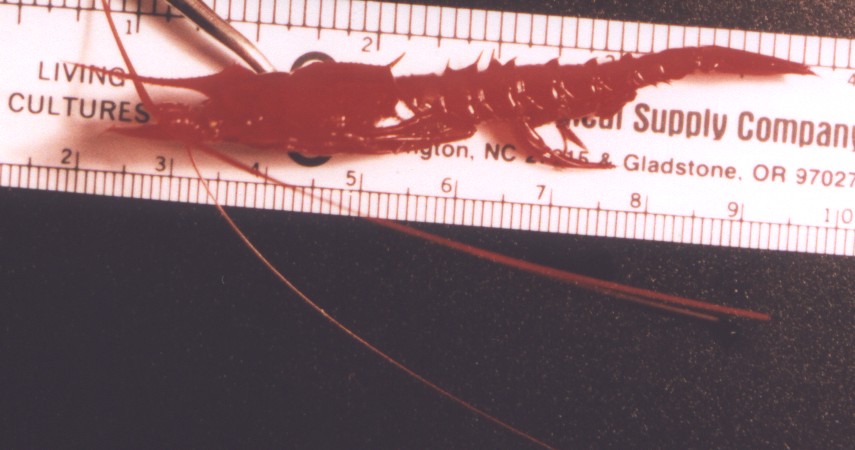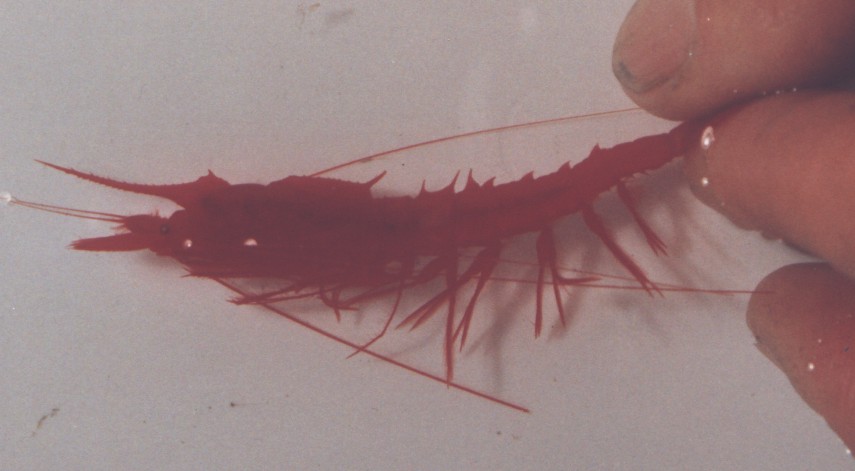Gnathophausia gracilis Willemoes-Suhm, 1875Common name(s): |
|
| Synonyms: Gnathophausia bidentata, Gnathophausia brevispinis, Gnathophausia dentata |  |
| Phylum Arthropoda
Subphylum Crustacea Class Malacostraca Subclass Eumalacostraca Superorder Peracarida Order Lophogastrida Family Lophogastridae (or Gnathophausiidae) |
|
| Gnathophausia gracilis from 100 mi off Point Conception, CA. Depth about 1000 m. | |
| (Photo by: Dave Cowles, May 1996) | |
How to Distinguish from Similar Species: Gnathophausia gracilis can be most readily distinguished from other Gnathophausia species by the large spines projecting dorsally along the dorsal abdominal ridge, along with the sinuous dorsal margin of the carapace with an interrupted ridge. It also has a mid-dorsal spine projecting posterodorsally at an angle at the posterior end of the carapace.
Geographical Range: Worldwide in tropical and temperate seas. To approximately 40 degrees N in the eastern Pacific, 20 20 degrees S. Especially common in the eastern tropical Pacific.
Depth Range: 900-2500 m (off S CA)
Habitat: Bathypelagic
Biology/Natural History: This is the second most common Gnathophausia species at bathypelagic depths off southern California, after Neognathophausia ingens (Cowles personal observation). The animal lives below the most severe part of the oxygen minimum layer off southern California, and probably experiences oxygen tensions down to about 10 mm Hg (6.5% of saturation) (Childress, 1975). It is about 80% water by weight. It is negatively buoyant (Childress and Nygaard, 1974) so it must swim constantly throughout its life to maintain its depth in the water. This species seems to have the most primitive foregut of all the mysids examined (De Jong-Moreau and Casanova, 2001). This species may attain sexual maturity at a smaller size in the Pacific than in the Atlantic (Fage, 1941).
Gnathophausia gracilis is sometimes
parasitized by an ellobiopsid
flagellate protozoan, Amallocystis fascitus, which
forms a cluster
of white filaments on the ventral side of the anterior abdominal
segment.
The parasite seems to be associated with the main nerve ganglion in
this
segment, and is associated with hypertrophy of the ganglion.
In N.
ingens this parasite also retards sexual maturation
such as retarded
development of oostegites in females and feminizing changes in males,
but
these changes may not be as pronounced in G. gracilis.
| Return to: | |||
| Main Page | Alphabetic Index | Systematic Index | Glossary |
References:
Dichotomous Keys:Pequegnat, Linda H., 1965. The bathypelagic mysid Gnathophausia (Crustacea) and its distribution in the eastern Pacific Ocean. Pacific Science 19:4 399-421
General References:
Scientific Articles:
Childress, J.J., 1975. The respiratory rates of midwater
crustaceans
as a function of depth of occurrence and relation to the oxygen minimum
layer off Southern California. Comp. Biochem. Physiol. 50A:
787-799
Childress, J.J. and M. Nygaard, 1974. Chemical composition and buoyancy of midwater crustaceans as function of depth of occurrence off Southern California. Marine Biology 27: 225-238
De Jong-Moreau, L. and J.-P. Casanova, 2001. The foreguts of the primitive families of the Mysida (Crustacea, Peracarida): a transitional link between those of the Lophogastrida (Crustacea, Mysidacea) and the most evolved Mysida. Acta Zoologica (Stockholm) 82: 137–147
Fage, Louis, 1941. Mysidacea, Lophogastrida, I. Dana Report 19: 1-52
Ortmann A.E., 1906. Schizopod Crustaceans in the United States National Museum- the Families Lophogastridae and Eucopiidae. Government Printing Office, Washington DC
Pequegnat, Linda H., 1965. The bathypelagic mysid Gnathophausia
(Crustacea) and its distribution in the eastern Pacific
Ocean. Pacific
Science 19:4 399-421
Web sites:
General Notes and Observations: Locations, abundances, unusual behaviors:

Here is another individual, from San Clemente Basin, CA.
Photo
by Dave Cowles
Authors and Editors of Page:
Dave Cowles (2006): Created original page